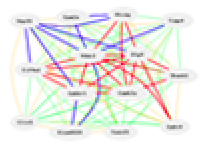

|

|

|
| | | | | | | | | | Welcome! Login |
Data Set Group2: RTI RCMRC BXD Fecal Metabolites CD+HFD (Aug14) Log2
|
|
|
| Specifics of this Data Set: |
| None |
| Summary: |
| The goal of this project is to study expression of a large set of defined and undefined metabolites in fecal samples from a genetically diverse set of BXD mouse strains (females) raised either on a high fat diet or low fat diet. Samples were taken from animals at sacrifices directly from the large intestine. Aim: Effect of genetics and diet on fecal metabolomics Use UPLC-MS Broad Spectrum Metabolomics to study:
To capture the most signal, all samples were analyzed under positive and negative ion mode using a reversed-phase separation. |
| About the cases used to generate this set of data: |
| All animals are females sacrificed as part of an NIA grant to RW Williams to study effects of diet on aging (longevity) in the BXD strains. A subset of females were sacrificed at specific ages for tissue harvesting and fecal pelltets from these animals were removed from the large intestine by K. Mozhui and snap frozen in liquid nitrogen prior to shipping to RTI. Three large data sets in GeneNetwork with a common set of 4091 metabolite entries per data set (high fat, chow diet, and combined) and for as many as 18 strains. |
| About the tissue used to generate this set of data: |
| Fresh fecal pellets taken directly at dissection from the lower GI tract by Dr. Khyobeni Mozhui. |
| About the array platform: |
| This is LC-MS data. Analysis exploited a Chenomx library at RTI with many updated metabolite identifications from the standard Chenomx library. Note that a single m/z ratio can correspond to multiple metabolites. |
| About data values and data processing: |
| |
| Notes: |
| For symbols of metabolites if the differences were greater than .0003 proportional m/z units (m/z difference divided by m/z value) then the symbol was labeled "circa" after the atomic composition. For description of metabolites if the proportional difference of the m/z ratio between Evan's EPFL Polar metabolite assignments and RTI assignments was very low (<.0001 proportional m/z units) then the symbol and description was taken directly from Evan's metabolite file, but if differences were between 0.0001 and about .0003 proportional m/z units then the descriptions were labeled "Putative" . If the differences were greater than .0003 units, then the descriptions were labeled "Provisional". For example, "Provisional assignment. Vanilpyruvic acid is a catecholamine metabolite and precursor to vanilactic acid. Accumulation in urine is indicative of Aromatic L-aminoacid decarboxylase deficiency (PMID 16288991)." by Rob Williams and Arthur Centeno, Aug 25, 2014 |
| Experiment Type: |
| Sample Preparation Summary
Instruments for LC-MS Analysis UPLC-MS Solutions(Reversed Phase)
|
| Contributor: |
| 1. Susan Sumner. PI of grant 2. Robert Clarke. Lead investigator on this project 3. Robert W. Williams. Lead geneticist and data entry 4. Khyobeni Mozhui: Fecal tissue collection from aging colony samples 5. Lu Lu: worked on experimental design, organized tissue acquistion, and prepared summary Excel spreadsheets of animals to be used. |
| Citation: |
| None as of Nov 2015 |
| Data source acknowledgment: |
| This work done in collaboration with RTI under a special pilot project grant from the RCMRC Center. 1. Dr. Susan Sumner. PI of grant 2. Dr. Robert Clarke. Lead investigator on this project 3. Surja Dhungana |
| Study Id: |
| 236 |

|
Web services initiated January, 1994 as Portable Dictionary of the Mouse Genome; June 15, 2001 as WebQTL; and Jan 5, 2005 as GeneNetwork. This site is currently operated by Rob Williams, Pjotr Prins, Zachary Sloan, Arthur Centeno. Design and code by Pjotr Prins, Zach Sloan, Arthur Centeno, Danny Arends, Christian Fischer, Sam Ockman, Lei Yan, Xiaodong Zhou, Christian Fernandez, Ning Liu, Rudi Alberts, Elissa Chesler, Sujoy Roy, Evan G. Williams, Alexander G. Williams, Kenneth Manly, Jintao Wang, and Robert W. Williams, colleagues. |

|

|
GeneNetwork support from:
|
|||
| It took 0.062 second(s) for tux01.uthsc.edu to generate this page | |||
